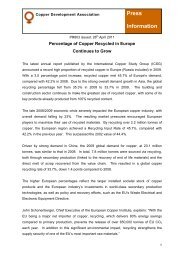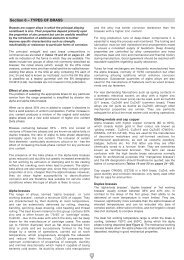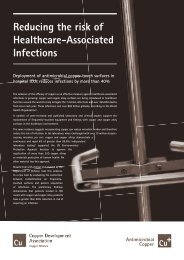Clinical Case Study: Selly Oak Hospital, Birmingham - Copper ...
Clinical Case Study: Selly Oak Hospital, Birmingham - Copper ...
Clinical Case Study: Selly Oak Hospital, Birmingham - Copper ...
You also want an ePaper? Increase the reach of your titles
YUMPU automatically turns print PDFs into web optimized ePapers that Google loves.
Practical Aspects of Reducing Bioburden with <strong>Copper</strong><strong>Clinical</strong> <strong>Case</strong> <strong>Study</strong>: <strong>Selly</strong> <strong>Oak</strong> <strong>Hospital</strong>, <strong>Birmingham</strong>CDA Publication 2022009
Practical Aspects of Reducing Bioburden with <strong>Copper</strong><strong>Clinical</strong> <strong>Case</strong> <strong>Study</strong>: <strong>Selly</strong> <strong>Oak</strong> <strong>Hospital</strong>, <strong>Birmingham</strong>IntroductionThere is now substantial scientific evidence to support the replacement of frequently touched equipment and fittings in the clinical environmentwith those incorporating copper to reduce contamination and therefore reduce the risk of infection. The <strong>Copper</strong> <strong>Clinical</strong> Trial, conducted on abusy medical ward at <strong>Selly</strong> <strong>Oak</strong> <strong>Hospital</strong>, demonstrated a 90-100% reduction in contamination on copper-containing vs standard surfaces. Theexperience of fitting out the test ward with a full range of copper-containing products has made a major contribution to the understanding ofthe practical application of the science.The <strong>Selly</strong> <strong>Oak</strong> trial has allowed the simplicity of the installation of copper-containing touch surfaces to be appreciated by all concerned, and hasalso initiated a series of developments within the supply chain resulting in the availability of key, uncoated copper and copper alloy products forward fit-outs at a cost comparable to standard components.This publication draws on the experience of the <strong>Selly</strong> <strong>Oak</strong> copper fit-out to outline the steps needed for the identification of touch surface hotspots, toexplain the simplicity of the installation and maintenance of these components and to consider retrofitting costs. This case study is a significant steptowards the development of best practice in incorporating copper in the clinical environment to optimise hygiene and help reduce the spread ofinfection. Cost data has been extrapolated from the test ward configuration (Nightingale) to an all single-room configuration and is also presented here.Multidisciplinary Team ApproachThe clinical trial at <strong>Selly</strong> <strong>Oak</strong> had input from clinicians, nurses, infection control practitioners and the Estates team to ensure that:◆ the surfaces at highest risk of being contaminated, and which therefore act as reservoirs of infection, were selected for substitution withcopper fittings and equipment◆ the integration of copper into those surfaces was practical and cost-effective◆ installation was carried out with minimal disruption to the working ward◆ the copper surfaces were assessed for impact on environmental contamination under everyday use◆ the needs of staff, visitors and patients were not compromised.The Test WardThe site of the trial is a 20-bedded acute medical ward, B4. The layout is a traditional Nightingale style ward with 2 side rooms, one single roomand one double room. The ward is mixed sex with separate toilet and washing facilities. The female area is comprised of two toilets, two separatesinks and a bathroom. The male toilets are the same but also have a shower area. Other rooms include a clinical treatment room, kitchen, staffroom and staff office. Also at the end of the ward there is a patient day room.Male bathroomTreatment roomSide roomKitchenMain wardEntranceDay roomStaff officeSide roomFemale bathroomSluice roomLayout of test ward, B4
Identification of Touch Surfaces ‘Hotspots’The trial team drew on their joint experience to select the surfaces at the greatest risk ofbeing contaminated through everyday use. These were added to the ‘wish list’ of productsfor substitution with copper-containing material (see below). While any copper surface canhelp reduce contamination, there is a critical set of surfaces for each type of clinicalenvironment which would need to incorporate copper.cistern flush levers dressings trolleys soap dispensers*apron dispensers* towel dispensers* commodessink traps and wastes # call buttons* push platesthumb turns cubicle locks grab railshot and cold taps toilet seats light switchespower sockets bed table tops drip pole stand**These ‘wish list’ components were not available in time to be installed but are now underdevelopment.# While these are not touch surface items, concerns were raised about Pseudomonasaeruginosa colonising standard plastic sink traps and wastes and so these were substitutedwith copper traps and brass wastes.Design and Supply of ComponentsA group of manufacturers were co-ordinated by <strong>Copper</strong> Development Association to providethe necessary like-for-like copper products, adapting their ranges to match existing fittings orprototyping new designs. Where possible, products made from solid copper or copper alloyswere used as this avoided the need to monitor surface wear and consider replacement. Dueto time constraints and a deadline for installation of products for inclusion in the trial, somecoated products were used, for example the copper-composite spray-coated toilet seats andthe copper electroplated flush handle. For the majority of the other products, manufacturersused solid copper, brass and bronze alloys with a minimum copper content of 60% (formaximum antimicrobial efficacy) and supplied products without wax or other surfacecoatings.Verification and Fitting of Components<strong>Copper</strong> products were delivered to the Estates team, who verified their suitability andorganised installation. Fitting of all the components proved trouble-free, there being nospecialist training required. Maintenance was also negligible (at the time of writing, mostfittings have been on the ward for nearly two years). Early reported complaints of sinkwastes becoming clogged was soon tracked down to an inappropriate disposal of solids downthe sinks.Installation TimesInstallation times for copper fittings were no different to standard fittings. Example fittingtimes are given below (provided by <strong>Selly</strong> <strong>Oak</strong> Estates Team).ComponentHandles, locks, push plates and kick platesLight switches and power socketsTaps, traps and wastesToilet seats and cistern flushTotal 20 bed Nightingale ward with side rooms and all shared servicesTotal 20 single rooms and all shared servicesFitting Time30 mins each20 mins each2.5 hours each20 mins each164 hours593 hours
Initial Evaluation of Staff and Patient AcceptanceThe items were installed at least six-months prior to commencement of the study to allow both healthcare workers and domestic staff to becomeaccustomed to the copper-containing fixtures. During the ‘bedding in’ period, staff, patients’ and visitors’ questions regarding the visually distinctcomponents (red, gold, bronze colours) were addressed via an information sheet.CleaningThe domestic staff followed their standard ward cleaning timetable. The same cleaning agents (Chlor-clean [sodium dichloroisocyanurate with1000ppm available chlorine and detergent], Guest Medical, UK) and protocol were used for both copper and non-copper-containing items. <strong>Copper</strong> andcopper alloys surfaces are active and will darken (oxidise) in situ. Fortunately, the oxidised surface is more active at killing germs. This oxide layer willwear away with frequent touch (for example on a brass hand rail) to reveal the original colour. Oxidation more severe than this darkening will onlyoccur in the absence of cleaning.CostGiven that the trial ward was a typical 20 bed unit with some side rooms, it was considered reasonable that this would form the basis of a costexercise. This is also typical of the size of many single bedded, en-suite hospital unit situations. It is expected that copper alloy fittings will beinstalled as part of regular planned maintenance or complete refurbishment projects. This means that the fittings cost will be identical with thatof fitting germ harbouring stainless steel, aluminium or plastic. However, if the refit project needs to include labour times, these have beenprovided by the <strong>Selly</strong> <strong>Oak</strong> Estates Team (see earlier section).The cost differentials were primarily associated with just three items: the toilet seat, dressings trolley and over-bed table. The toilet seat includesa composite material that is at present expensive to apply; the cost will be significantly reduced when the technology is applied industrially. Theother two items were custom made for the trial and therefore reflect high labour costs; in both cases the industrialisation process will bringdown these costs significantly. But for the short term these products will inevitably command a premium price.Conclusions<strong>Copper</strong> and copper alloy fittings are proven to reduce environmental contamination on their surfaces in the clinical environment by between 90and 100%, so making a contribution to improved hygiene. Some touch surface products such as door furniture and sanitary fittings are alreadyavailable in uncoated copper or copper alloys and new products and equipment are now under development. ‘Ward solution’ - sets ofcomponents - will vary according to the type of ward and factors such as patient mobility. Components are familiar, easy to install and have longservice lives. Products made from solid materials will remain effective in killing germs throughout their lives, even if scratched. This case studyshows a zero capital cost differential for copper vs standard components when considering items already in production, and only a £6-7kadditional cost when including the three prototyped products (over-bed tables, dressings trolley and toilet seat). This is equivalent to the(admitted) cost of one infection.Further InformationVisit www.antimicrobialcopper.com for information on the antimicrobial properties and applications of copper, read FAQs and view the onlineproduct catalogue.Acknowledgements<strong>Copper</strong> Development Association (CDA) thanks the <strong>Selly</strong> <strong>Oak</strong> Estates Team for their support throughout the trial and for providing installationtimes for this case study. CDA acknowledges the support and generosity of the following companies who have provided materials, suppliedproducts and developed prototypes for the trial:Aalco Frank Allart and Co Ltd Allgood plc Armack Chemicals LtdAssa Abloy Aurubis UK Ltd Barwood Products (Staff) Ltd Blackheath TubeB Mason and Sons Ltd Columbia Metals Ltd Doyle & Tratt Products Ltd Dudley IndustriesIBP Conex Ltd KME UK Luvata McDonald Diecasting LtdMercury Composites Nottingham Rehab Supplies OMC Technologies Parker PensRycroft Ltd TG Stamping & Machining Ltd Triflow Concepts Ltd Union Architectural HardwareW & S Allely Ltd<strong>Copper</strong> Development Association5 Grovelands Business CentreBoundary WayHemel Hempstead, HP2 7TEUKwww.copperinfo.co.ukhelpline@copperdev.co.ukwww.antimicrobialcopper.com
















